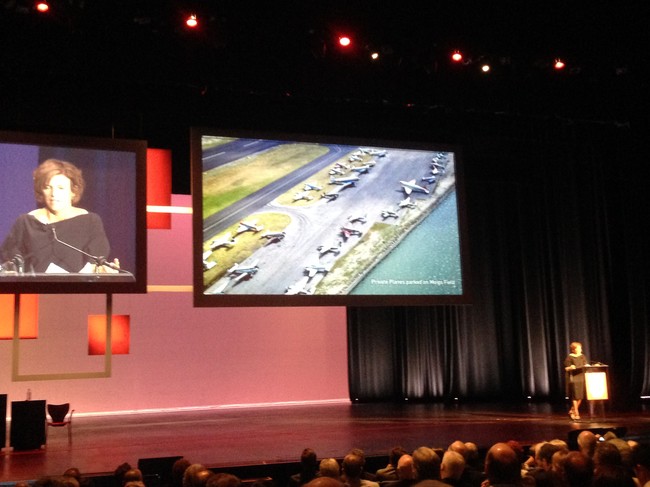
Jeanne Gang discusses her firm's plan for Chicago's Northerly Island at the opening of the 2014 AIA convention.
Chicago’s own Jeanne Gang posed several questions to the audience at the opening of the 2014 AIA Convention this morning. “How do you get purpose?,” was her first. And one that echoed throughout the talk.
Gang recounted that her life and professional experiences have taught her that finding purpose in design work is a function of aligning process with the larger issues facing urban areas. She challenged architects and other design professionals to leverage their profession to help spark social change.
“Does architecture create social change, or is it social change that determines architecture?,” she asked. “Social change is reliant on spatial change to achieve it’s real potential,” she continued, later in the talk. “But it’s a dialectical relationship.”
Gang explained how the industrial heritage and modern challenges of Chicago and its waterways have underpinned much of the work by her firm, Studio Gang. She gave the examples of the Ford Calumet Environmental Center, on the city’s South Side, two remarkable boathouses, and most substantially, her firm’s plan for Northerly Island.
Originally envisioned by Chicago Planner Daniel Burnham as a 90-acre green space, by 1950, the island in Lake Michigan was largely hardscape and housed public airport operated for private planes. Studio Gang’s plan for the space is currently under construction and will include aquatic and migratory bird habitat, along with extensive recreational opportunities for people.
“It’s actually under construction,” Gang said. “We thought it would take 50 years, but it’s actually under construction. Right now it’s the largest urban aquatic restoration in the world.”
Also running through her presentation, as it does through the city, was the Chicago River. Her studio received the commissions for two out of four new boathouses along the river, projects that dovetailed with her earlier work on the Calumet River. The boathouses constitute “a change in the way that the public is allowed to access the river,” Gang says. “Dirty or not, we’re going to care about it and we’re going to access it.”
With a sense of urgency, she emphasized for the AIA audience that environmental protection—and creating design that facilitates its protection—is the challenge facing the architectural profession.
“Things are going to have to change,” she said. “Architects, the way that we think, are perfectly positioned to make a difference. It’s what we take part in that helps drive change. We are all in a process of aligning global issues with the opportunities available to each of us in design.”

Post a comment to this article
Report Abusive Comment